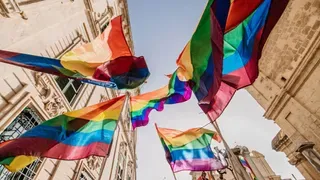June 25, 2010
Gay Bars, Gay History
Kevin Mark Kline READ TIME: 5 MIN.
The recent news that the nation's oldest gay bar is closing has focused attention once again on the beleaguered state of our most hallowed institution, the local gay bar.
The Cedar Brook Caf�, is located in tiny Westport, CT (that's where Lucy and Ricky Ricardo moved when they left New York City.) That might be an unlikely place for such a landmark. But it actually embodies the unique place the gay bar holds in American culture.
For decades, gay bars served as the place where gay men and lesbians came out. They served as our town hall, where injustices were discussed and coping mechanisms were worked out. They were the place where information was disseminated, everything from what park the cops were raiding that week to a gay bashing. Most of all, they were our safe havens. They were the only places were we could be ourselves. The only places where we could be gay.
More than one historian has commented, as did the New York Times' Stephen Holden, in a recent review of a new documentary, Stonewall Uprising, that, "gay bars offered the same kind of social haven for an oppressed minority as black churches in the South before the Civil Rights movement."
Read any of the recent histories (they're all recent, because until the 1970s, we were essentially invisible and certainly not a worthy object of study) of gay life in America before Stonewall. All of them spend most of their time discussing bars.
And what about Stonewall? Do you believe that it was some cosmic joke that our Bastille, our Bunker Hill, was ...a bar? Stonewall (Riots or Rebellion - take your pick), as everyone now knows, was a seedy, dark Mafia-controlled dive bar in Greenwich Village, where, on the evening of June 28, 1969, the police came in to make a routine sweep of arrests of queers for the crime of socializing together. The resulting three-day disturbances along Christopher Street and environs were our Big Bang, the explosion that set the modern gay-rights movement in motion.
In fact, Stonewall was not the first police-gay bar riot. There were two others, both on the West Coast. Technically, the Compton Cafeteria Riot of 1966 was not "gay" per se, but transgender. The patrons of a popular eating spot in San Francisco's Tenderloin were picked out for cross-dressing. Gay men and lesbians joined an impromptu picket of the cafeteria. There was another fracas in a bar in West Los Angeles only a few years before Stonewall.
What happened at Stonewall was world historical because it marked the first sustained populist action by LGBT people against repression in modern times (aided by the anarchists, hippies and radicals who made up much of Greenwich Village at the time). It also was in the right place at the right time, coming as it did in an area of a big city amenable to radical causes and at the end of a decade that had seen a burst of "liberation" movements among aggrieved people. And it could only have happened at a bar.
That's the point: We were rioting over a bar. Too many people these days see gay bars as anachronisms. People in 1969 knew how to fight for their right to party.
Today, we hear that it's a different story. Who needs bars to meet other gay folks, some say, when we have Manhunt and Facebook? Some argue on moral grounds: Bars are for, well, drinking, and it's true that LGBT rates of alcoholism tend to trend upward of the general population. Furthermore - or so the argument goes - why should we be ghettoizing ourselves? We're welcomed in straight bars and (as I wrote in a recent issue of noiZe) straight people are welcomed in ours.
The popular sentiment has gotten so widespread that Entrepreneur magazine, in a widely quoted article on the 10 most endangered businesses, put gay bars right up there with film camera manufacturers and used bookstores.
But before we put down our last frozen cosmo, it's worth taking a second look at the legacy these bars have given us. Gay bars once served as the epicenter of gay culture. They were the only places where we could openly socialize. Have blacks given up on historically black churches because they have become more successfully integrated into the mainstream of American life and Jim Crow is dead? Have Hispanics discarded the Catholic Church?
There's another aspect to bars, something that we might want to consider before we leave them for the comfort of our cathode ray home screens. Sociologist Robert Putnam caused a stir and coined a term when a wrote an essay and then book called Bowling Alone. Putnam detailed the anomie that has infected American society. "Americans are right that the bonds of our communities have withered," Putnam wrote, "and we are right to fear that this transformation has very real costs."
For gay men, the vast majority of whom live the first part of their lives in a terrible isolation, it seems unfair and unworthy to ask them to spend the second and third parts alone. Yes, some gay bars are pretentious. Some overcharge for drinks. Some cater to patrons with attitude toward whoever is unlike themselves. They can be loud. People can get messy. And there's the drive home.
But even with all those caveats, the modern gay bar still serves a function. It's a place where we can meet our friends and make new ones. It's where we hear the latest gossip and discuss politics (if we can be heard above the music). It's where we catch what other people are wearing, whom they're seeing, how they're faring.
In a recent issue of local New York gay magazine Next, Andrew Belonsky once again raises the question, "Is this the end of the gay bar?" He hopes not. "Gay bars are more than the local watering hole where you act a fool without repercussion," he writes. "They're monuments - sites of resistance and change. They're different things for different people. But, through it all, they're influential and deeply intimate places. Places we will always need."
And now Connecticut's Cedar, at the venerable age of 71 years of age, is serving its final last call. It joins institutions we thought would always be there. Places like the Boom Boom Room in Laguna Beach. Uncle Charlie's in New York. The Black Cat in San Francisco.
Are we doomed to only cherish our local public houses when they are no more?






